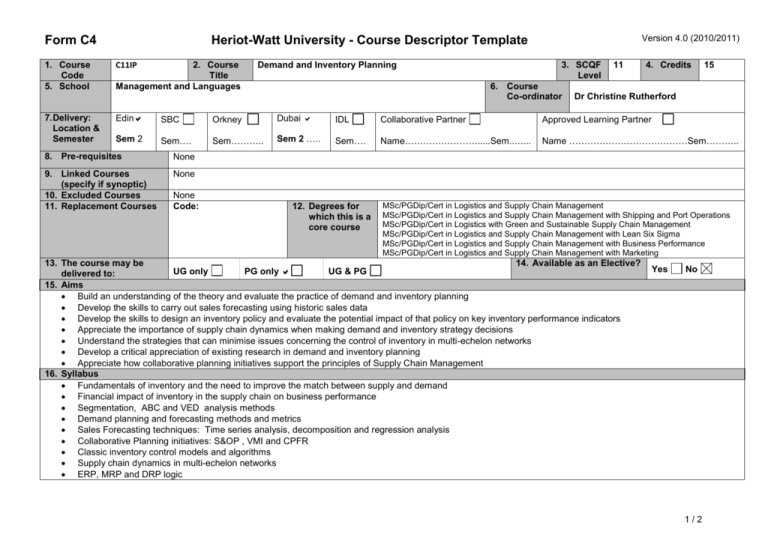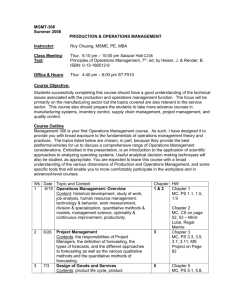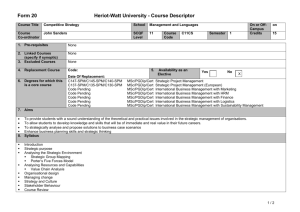C11IP_C4 - Heriot
advertisement

Form C4 1. Course Code 5. School 7. Delivery: Location & Semester Version 4.0 (2010/2011) Heriot-Watt University - Course Descriptor Template 2. Course Title Management and Languages C11IP Demand and Inventory Planning 3. SCQF Level 6. Course Co-ordinator 11 4. Credits 15 Dr Christine Rutherford Edin SBC Orkney Dubai IDL Collaborative Partner Approved Learning Partner Sem 2 Sem…. Sem……….. Sem 2 ….. Sem…. Name…………………….....Sem..…... Name …………………………………Sem……….. 8. Pre-requisites None 9. Linked Courses (specify if synoptic) 10. Excluded Courses 11. Replacement Courses None None Code: 12. Degrees for which this is a core course MSc/PGDip/Cert in Logistics and Supply Chain Management MSc/PGDip/Cert in Logistics and Supply Chain Management with Shipping and Port Operations MSc/PGDip/Cert in Logistics with Green and Sustainable Supply Chain Management MSc/PGDip/Cert in Logistics and Supply Chain Management with Lean Six Sigma MSc/PGDip/Cert in Logistics and Supply Chain Management with Business Performance MSc/PGDip/Cert in Logistics and Supply Chain Management with Marketing 13. The course may be 14. Available as an Elective? UG only PG only UG & PG delivered to: 15. Aims Build an understanding of the theory and evaluate the practice of demand and inventory planning Develop the skills to carry out sales forecasting using historic sales data Develop the skills to design an inventory policy and evaluate the potential impact of that policy on key inventory performance indicators Appreciate the importance of supply chain dynamics when making demand and inventory strategy decisions Understand the strategies that can minimise issues concerning the control of inventory in multi-echelon networks Develop a critical appreciation of existing research in demand and inventory planning Appreciate how collaborative planning initiatives support the principles of Supply Chain Management 16. Syllabus Fundamentals of inventory and the need to improve the match between supply and demand Financial impact of inventory in the supply chain on business performance Segmentation, ABC and VED analysis methods Demand planning and forecasting methods and metrics Sales Forecasting techniques: Time series analysis, decomposition and regression analysis Collaborative Planning initiatives: S&OP , VMI and CPFR Classic inventory control models and algorithms Supply chain dynamics in multi-echelon networks ERP, MRP and DRP logic Yes No 1/2 Form C4 Version 4.0 (2010/2011) Heriot-Watt University - Course Descriptor Template 17. Learning Outcomes (HWU Core Skills: Employability and Professional Career Readiness) Subject Mastery Understanding, Knowledge and Cognitive Skills Scholarship, Enquiry and Research (Research-Informed Learning Develop in depth knowledge and understanding of relevant demand and inventory management concepts Analysis of historic sales data and its use in inventory planning Develop awareness of the impact of forecasting and Develop ability to evaluate alternative inventory control models and forecasting inventory on supply chain performance methods Critically appreciate the complexities and dynamics of Develop ability to analyse problems through course work and in examination. managing inventories in multi-echelon network Personal Abilities Industrial, Commercial & Professional Practice Have the skills and knowledge to evaluate and select the most suitable inventory strategy for different product /customer segments Be able to segment inventories using relevant criteria Be able to carry out sales forecasting using appropriate methods Understand the practical limitations of various forecasting and inventory models Autonomy, Accountability & Working with Others Group and class discussion Develop interpersonal skills and practice the skills required for working in groups Work independently to develop skills required of demand and inventory planners 18. Assessment Methods Method Date of Proposal 13 November 2013 Communicate effectively with team members and write up a joint report Use of spread-sheets to carry out time series analysis Analysis of case data in group coursework 19. Re-assessment Methods Duration of Exam Weighting (%) Synoptic courses? Method (if applicable) Examination Coursework 20. Date and Version Communication, Numeracy & ICT 3 hours Duration of Exam (if applicable) 60% 40% Date of Approval by School Committee None Examination Date of Implementation 3 hours Version Number 2/2 Diet(s)






